2017 KIA CARENS RHD warning light
[x] Cancel search: warning lightPage 54 of 723
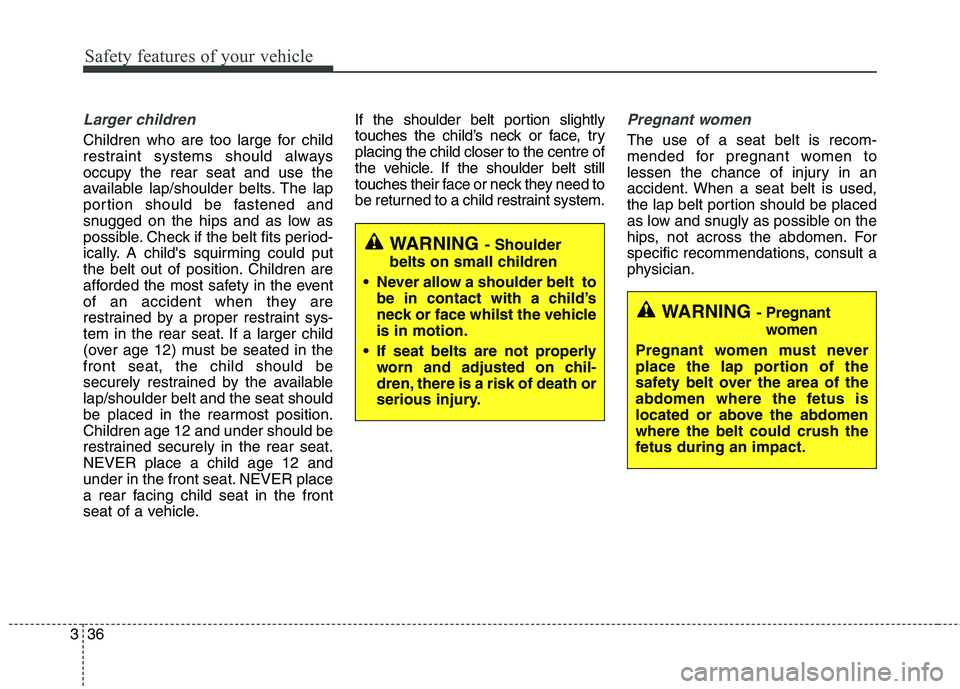
Safety features of your vehicle
36
3
Larger children
Children who are too large for child
restraint systems should always
occupy the rear seat and use the
available lap/shoulder belts. The lap
portion should be fastened and
snugged on the hips and as low as
possible. Check if the belt fits period-
ically. A child's squirming could put
the belt out of position. Children are
afforded the most safety in the event
of an accident when they are
restrained by a proper restraint sys-
tem in the rear seat. If a larger child
(over age 12) must be seated in thefront seat, the child should be
securely restrained by the availablelap/shoulder belt and the seat should
be placed in the rearmost position.Children age 12 and under should be
restrained securely in the rear seat.NEVER place a child age 12 and
under in the front seat. NEVER place
a rear facing child seat in the front
seat of a vehicle. If the shoulder belt portion slightly
touches the child’s neck or face, tryplacing the child closer to the centre of
the vehicle. If the shoulder belt still
touches their face or neck they need to
be returned to a child restraint system.
Pregnant women
The use of a seat belt is recom-
mended for pregnant women to
lessen the chance of injury in an
accident. When a seat belt is used,
the lap belt portion should be placed
as low and snugly as possible on the
hips, not across the abdomen. For
specific recommendations, consult a
physician.
WARNING
- Shoulder
belts on small children
Never allow a shoulder belt to be in contact with a child’s
neck or face whilst the vehicleis in motion.
If seat belts are not properly worn and adjusted on chil-
dren, there is a risk of death or
serious injury.
WARNING - Pregnant
women
Pregnant women must never
place the lap portion of the
safety belt over the area of the
abdomen where the fetus is
located or above the abdomenwhere the belt could crush the
fetus during an impact.
Page 58 of 723
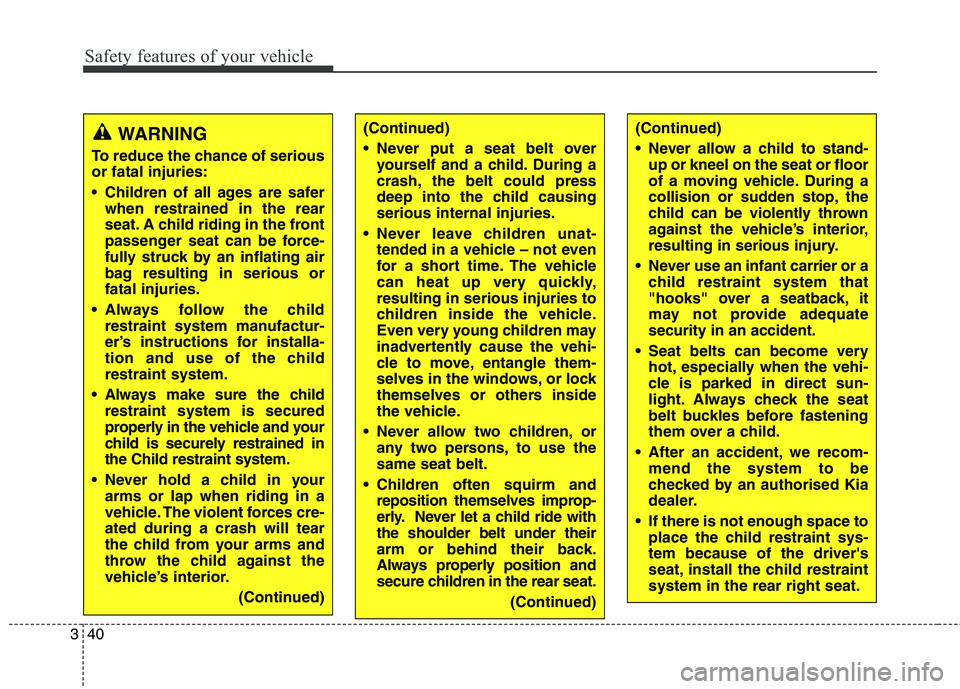
Safety features of your vehicle
40
3
WARNING
To reduce the chance of serious or fatal injuries:
Children of all ages are safer when restrained in the rear
seat. A child riding in the front
passenger seat can be force-
fully struck by an inflating air
bag resulting in serious orfatal injuries.
Always follow the child restraint system manufactur-
er’s instructions for installa-
tion and use of the childrestraint system.
Always make sure the child restraint system is secured
properly in the vehicle and your
child is securely restrained inthe Child restraint system.
Never hold a child in your arms or lap when riding in a
vehicle. The violent forces cre-ated during a crash will tear
the child from your arms and
throw the child against the
vehicle’s interior.
(Continued)(Continued)
Never put a seat belt overyourself and a child. During a
crash, the belt could press
deep into the child causingserious internal injuries.
Never leave children unat- tended in a vehicle – not even
for a short time. The vehicle
can heat up very quickly,resulting in serious injuries to
children inside the vehicle.
Even very young children may
inadvertently cause the vehi-
cle to move, entangle them-
selves in the windows, or lock
themselves or others inside
the vehicle.
Never allow two children, or any two persons, to use thesame seat belt.
Children often squirm and reposition themselves improp-
erly. Never let a child ride withthe shoulder belt under their
arm or behind their back.
Always properly position and
secure children in the rear seat.
(Continued)(Continued)
Never allow a child to stand-up or kneel on the seat or floor
of a moving vehicle. During a
collision or sudden stop, the
child can be violently thrown
against the vehicle’s interior,
resulting in serious injury.
Never use an infant carrier or a child restraint system that
"hooks" over a seatback, it
may not provide adequatesecurity in an accident.
Seat belts can become very hot, especially when the vehi-
cle is parked in direct sun-
light. Always check the seat
belt buckles before fastening
them over a child.
After an accident, we recom- mend the system to be
checked by an authorised Kia
dealer.
If there is not enough space to place the child restraint sys-tem because of the driver's
seat, install the child restraintsystem in the rear right seat.
Page 67 of 723
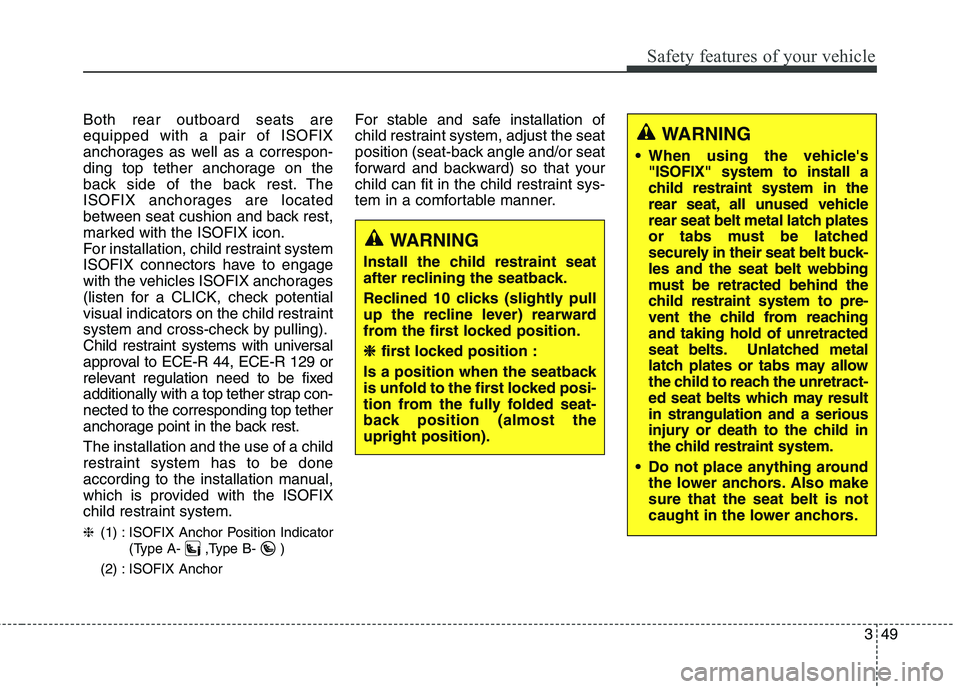
349
Safety features of your vehicle
Both rear outboard seats are equipped with a pair of ISOFIX
anchorages as well as a correspon-
ding top tether anchorage on the
back side of the back rest. The
ISOFIX anchorages are located
between seat cushion and back rest,
marked with the ISOFIX icon.
For installation, child restraint system
ISOFIX connectors have to engage
with the vehicles ISOFIX anchorages
(listen for a CLICK, check potential
visual indicators on the child restraint
system and cross-check by pulling).
Child restraint systems with universal
approval to ECE-R 44, ECE-R 129 or
relevant regulation need to be fixed
additionally with a top tether strap con-nected to the corresponding top tether
anchorage point in the back rest. The installation and the use of a child
restraint system has to be done
according to the installation manual,
which is provided with the ISOFIX
child restraint system. ❈(1) : ISOFIX Anchor Position Indicator
(Type A- ,Type B- )
(2) : ISOFIX Anchor For stable and safe installation of
child restraint system, adjust the seat
position (seat-back angle and/or seat
forward and backward) so that your
child can fit in the child restraint sys-
tem in a comfortable manner.
WARNING
Install the child restraint seat
after reclining the seatback.
Reclined 10 clicks (slightly pull
up the recline lever) rearward
from the first locked position. ❈
❈ first locked position :
Is a position when the seatback
is unfold to the first locked posi-
tion from the fully folded seat-
back position (almost theupright position).
WARNING
When using the vehicle's "ISOFIX" system to install a
child restraint system in the
rear seat, all unused vehicle
rear seat belt metal latch plates
or tabs must be latched
securely in their seat belt buck-les and the seat belt webbing
must be retracted behind the
child restraint system to pre-
vent the child from reachingand taking hold of unretracted
seat belts. Unlatched metal
latch plates or tabs may allow
the child to reach the unretract-
ed seat belts which may resultin strangulation and a serious
injury or death to the child in
the child restraint system.
Do not place anything around the lower anchors. Also makesure that the seat belt is not
caught in the lower anchors.
Page 75 of 723
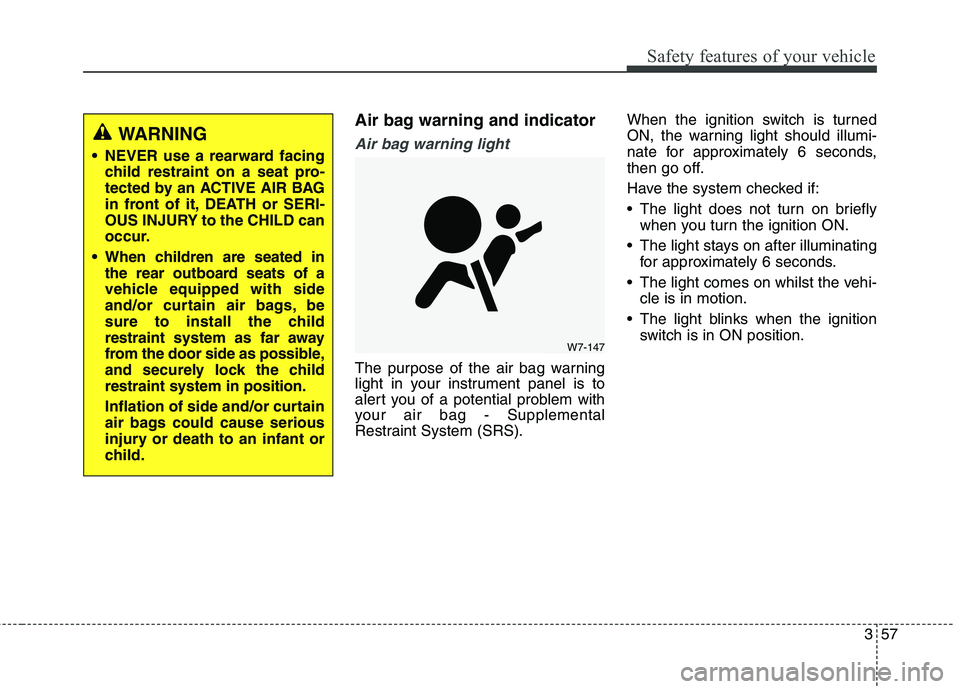
357
Safety features of your vehicle
Air bag warning and indicator
Air bag warning light
The purpose of the air bag warning
light in your instrument panel is to
alert you of a potential problem with
your air bag - Supplemental
Restraint System (SRS).When the ignition switch is turned
ON, the warning light should illumi-
nate for approximately 6 seconds,
then go off.
Have the system checked if:
The light does not turn on briefly
when you turn the ignition ON.
The light stays on after illuminating for approximately 6 seconds.
The light comes on whilst the vehi- cle is in motion.
The light blinks when the ignition switch is in ON position.
W7-147
WARNING
NEVER use a rearward facing child restraint on a seat pro-
tected by an ACTIVE AIR BAG
in front of it, DEATH or SERI-
OUS INJURY to the CHILD can
occur.
When children are seated in the rear outboard seats of a
vehicle equipped with side
and/or curtain air bags, be
sure to install the child
restraint system as far away
from the door side as possible,
and securely lock the childrestraint system in position.
Inflation of side and/or curtain
air bags could cause serious
injury or death to an infant or
child.
Page 77 of 723

359
Safety features of your vehicle
SRS components and functions
The SRS consists of the following components:
1. Driver's front air bag module
2. Passenger's front air bag module
3. Side air bag modules*
4. Curtain air bag modules*
5. Retractor pre-tensioner assemblies
6. Air bag warning light
7. SRS control module (SRSCM)
8. Front impact sensors
9. Side impact sensors*10. Passenger’s front air bag
ON/OFF indicator*
11. Passenger’s front air bag ON/OFF switch*
12. EFD (Emergency Fastening Device)*
* : if equipped
The SRSCM continually monitors all
elements whilst the ignition switch is
ON to determine if a frontal, near-frontal impact or side impact is
severe enough to require air bag
deployment or pre-tensioner seat belt
deployment.
The SRS air bag warning light on the
instrument panel will illuminate forabout 6 seconds after the ignition
switch is turned to the ON position,
after which the air bag warning lightshould go out.
ORP036093R
WARNING
If any of the following condi-
tions occurs, this indicates a
malfunction of the SRS. We rec-ommend that the system be
inspected by an authorised Kia
dealer.
The light does not turn on briefly when you turn the igni- tion ON.
The light stays on after illumi- nating for approximately 6seconds.
The light comes on whilst the vehicle is in motion.
The light blinks when the igni- tion switch is in ON position.
Page 79 of 723

361
Safety features of your vehicle
WARNING
Do not install or place any accessories (drink holder, CD
holder, sticker, etc.) on the
front passenger's panel above
the glove box in a vehicle with
a passenger's air bag. Such
objects may become danger-
ous projectiles and cause
injury if the passenger's air
bag inflates.
(Continued)
(Continued)
When installing a container ofliquid air freshener inside the
vehicle, do not place it near
the instrument cluster nor on
the instrument panel surface.
It may become dangerous pro-
jectiles and cause injury if the
passenger's air bag inflates.
OQL036109R
Passenger’s front air bag (if equipped)
WARNING
If an air bag deploys, there may be a loud noise followed by a fine dust released in the vehi-
cle. These conditions are nor-
mal and are not hazardous - the
air bags are packed in this fine
powder. The dust generated
during air bag deployment may
cause skin or eye irritation as
well as aggravate asthma for
some persons. Always wash all
exposed skin areas thoroughlywith cold water and a mild
soap after an accident in which
the air bags were deployed.
(Continued)
(Continued)
The SRS can function onlywhen the ignition key is in the
ON position. If the SRS air bagwarning light does not illumi-
nate, or continuously remains
on after illuminating for about 6
seconds when the ignition key
is turned to the ON position, or
after the engine is started,
comes on whilst driving, the
SRS is not working properly. If
this occurs, we recommendthat the system be inspected
by an authorised Kia dealer.
Before you replace a fuse or disconnect a battery terminal,
turn the ignition switch to the
LOCK position and remove
the ignition key. Never remove
or replace the air bag relatedfuse(s) when the ignition
switch is in the ON position.
Failure to heed this warning
will cause the SRS air bag
warning light to illuminate.
Page 81 of 723
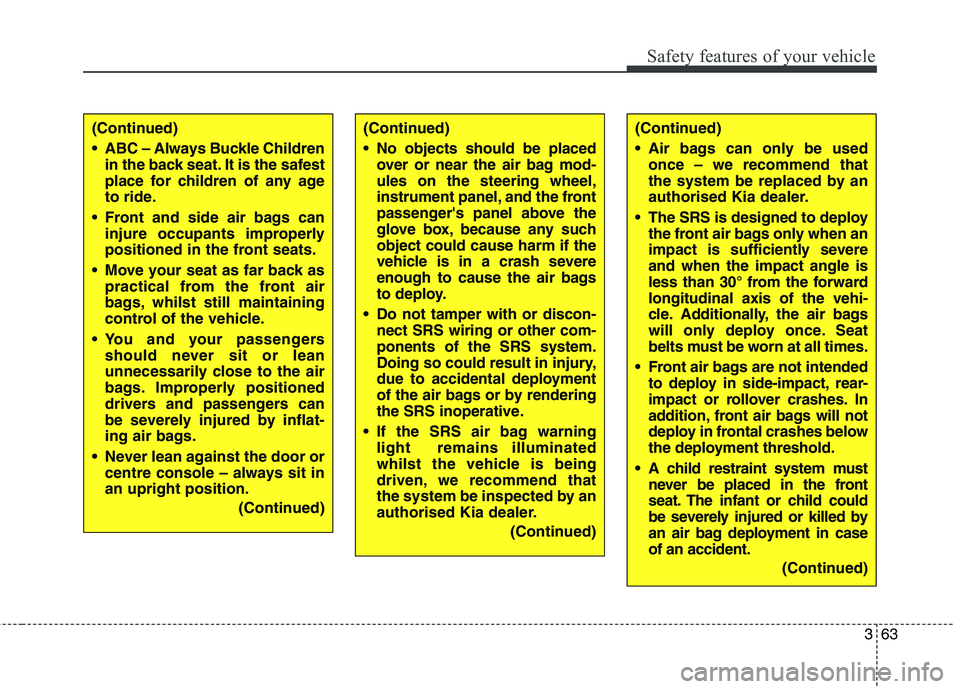
363
Safety features of your vehicle
(Continued)
ABC – Always Buckle Childrenin the back seat. It is the safest
place for children of any age
to ride.
Front and side air bags can injure occupants improperly
positioned in the front seats.
Move your seat as far back as practical from the front air
bags, whilst still maintaining
control of the vehicle.
You and your passengers should never sit or lean
unnecessarily close to the air
bags. Improperly positioned
drivers and passengers can
be severely injured by inflat-
ing air bags.
Never lean against the door or centre console – always sit inan upright position.
(Continued)(Continued)
No objects should be placedover or near the air bag mod- ules on the steering wheel,
instrument panel, and the front
passenger's panel above the
glove box, because any suchobject could cause harm if the
vehicle is in a crash severe
enough to cause the air bags
to deploy.
Do not tamper with or discon- nect SRS wiring or other com-ponents of the SRS system.
Doing so could result in injury,
due to accidental deployment
of the air bags or by rendering
the SRS inoperative.
If the SRS air bag warning light remains illuminated
whilst the vehicle is being
driven, we recommend that
the system be inspected by an
authorised Kia dealer.
(Continued)(Continued)
Air bags can only be usedonce – we recommend that
the system be replaced by an
authorised Kia dealer.
The SRS is designed to deploy the front air bags only when an
impact is sufficiently severeand when the impact angle is
less than 30° from the forwardlongitudinal axis of the vehi-
cle. Additionally, the air bags
will only deploy once. Seat
belts must be worn at all times.
Front air bags are not intended to deploy in side-impact, rear-
impact or rollover crashes. In
addition, front air bags will not
deploy in frontal crashes below
the deployment threshold.
A child restraint system must never be placed in the front
seat. The infant or child could
be severely injured or killed by
an air bag deployment in caseof an accident.
(Continued)
Page 84 of 723
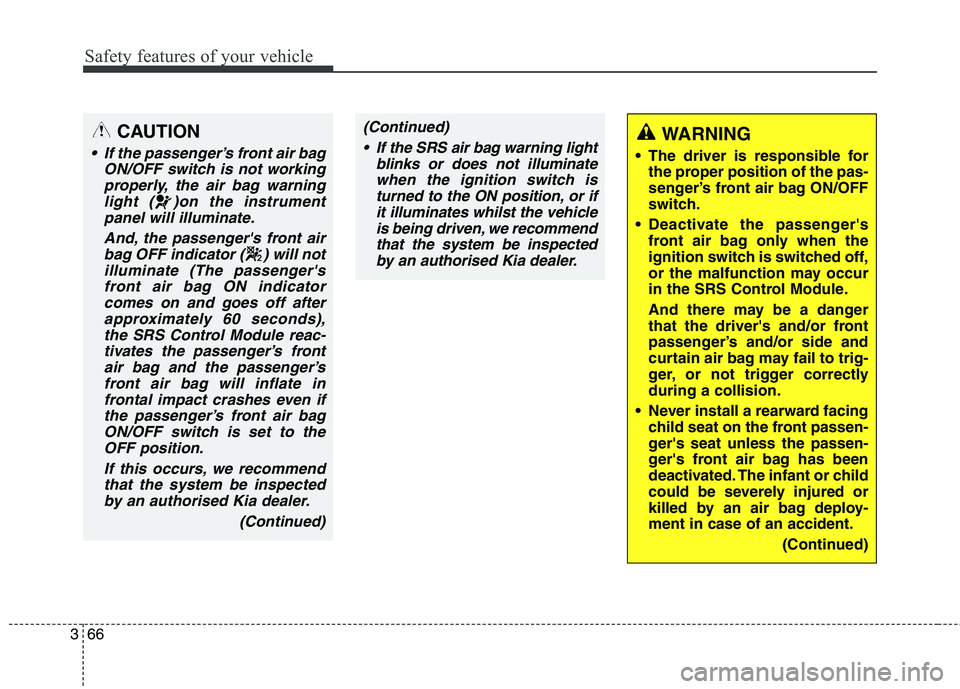
Safety features of your vehicle
66
3
(Continued)
If the SRS air bag warning light blinks or does not illuminatewhen the ignition switch is turned to the ON position, or ifit illuminates whilst the vehicleis being driven, we recommendthat the system be inspected by an authorised Kia dealer.CAUTION
If the passenger’s front air bag ON/OFF switch is not workingproperly, the air bag warninglight ( )on the instrumentpanel will illuminate.
And, the passenger's front airbag OFF indicator ( ) will not illuminate (The passenger'sfront air bag ON indicatorcomes on and goes off after approximately 60 seconds),the SRS Control Module reac-tivates the passenger’s front air bag and the passenger’sfront air bag will inflate infrontal impact crashes even if the passenger’s front air bagON/OFF switch is set to theOFF position.
If this occurs, we recommendthat the system be inspected by an authorised Kia dealer.
(Continued)
WARNING
The driver is responsible for the proper position of the pas-
senger’s front air bag ON/OFF
switch.
Deactivate the passenger's front air bag only when the
ignition switch is switched off,
or the malfunction may occur
in the SRS Control Module.
And there may be a danger
that the driver's and/or front
passenger’s and/or side and
curtain air bag may fail to trig-
ger, or not trigger correctlyduring a collision.
Never install a rearward facing child seat on the front passen-
ger's seat unless the passen-
ger's front air bag has been
deactivated. The infant or child
could be severely injured or
killed by an air bag deploy-ment in case of an accident.
(Continued)